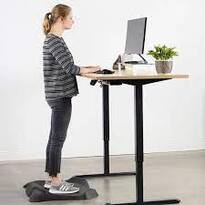 By Michael Staszak, PT Working long hours in the office can wreak havoc on your body if you don’t maintain good posture. Everyone has heard this and as a result, several ergonomic ‘solutions’ have been marketed to help alleviate back and body aches. Everything from yoga balls, kneeling chairs, standing desks, and more have been touted as the better options from sitting all day. But, are these alternatives really better for you? Let’s take a look at two of the most popular ergonomic options people consider — standing desks vs. traditional office chairs. Before we begin to address which option is better, it is important to understand what the correct posture looks like in both scenarios. Sitting Sitting for long periods becomes especially bad for your back and spine when done incorrectly. For example, sitting in a perched position where you are forward on your seat with your back hyperextended, or with your body slumped forward such that the natural curves are no longer present and your neck is stretched forward are both common and incorrect sitting postures. When your back is rounder (slumped), for example, you are placing three to four times more pressure on your spinal discs which can lead to long-term disc degeneration, muscle tightness, and compression in your neck. The Correct Way to Sit The ‘how to’ for sitting may seem fundamental however plenty of people sit incorrectly every day. To sit correctly means your back is straight with your shoulders back, your buttocks touching the back of the chair, and all three normal back cures should be present. Body weight should be distributed evenly on both hips, and your knees should be bent and even with the height of your hips. Standing Standing for long periods can be equally problematic as sitting, but in different ways. Most people have a weak core and lack the physical endurance needed to keep any one standing position for a length of time. As a result, shifts are made in how you stand resulting in compression on your feet and other joints, hyperextension of the lower back and legs, and misaligned hips or spine. The Correct Way to Stand Proper standing posture is not just standing upright. In fact, there is a bit more to it which might surprise you. Standing properly includes the following steps: bearing your weight evenly distributed on the front and back of your feet, keeping your knees slightly bent and feet shoulder-width apart, letting your arms hang down naturally on the sides of your body, standing straight and tall with your shoulders pulled backward, and keeping your abdominals gently engaged. To correctly sit or stand requires having adequate core strength and endurance, however most people have a weak core and lack the physical endurance needed to keep any one position for a length of time. As a result, compensations are used to make sitting or standing seem more comfortable, such as extending your legs and placing your feet up on a stool or coffee table, or putting more weight on one leg than the other when standing. If both sitting and standing can cause issues for your body, which is the better choice? Despite fairly effective marketing campaigns, sitting is the better option. Key to this choice, however, is that you are sitting in an ergonomically designed chair rated for the typical number of hours you sit during your workday. The primary reason sitting is the better choice is that the vast majority of people do not have the necessary core strength or the ability to maintain the proper standing posture for hours on end. And, no, a ball chair is not better as this requires even more core strength and stability from your body. Eventually, your body gets fatigued and your posture changes. A well designed chair provides your body support, even when you are feeling tired. But if your workplace has the means to provide an even better solution, it would be for you to have a workstation that can adjust in height from a sitting to a standing position. The variation in height provides your body the right mix of positions to minimize the negative impacts of sitting or standing too long. Engage both standing and sitting positions throughout your workday and your body will thank you. About the Author: Michael Staszak has been an outpatient orthopedic physical therapist for the past 27 years and is the owner of Staszak Physical Therapy & Wellness Center in Eugene. He and his staff believe that the more people understand how their bodies work and learn proper body mechanics, the less likely they are to become injured again. With this commitment to patient education, Michael provides wellness articles and presentations for businesses and community members. Photos from istockphoto.com
0 Comments
Your comment will be posted after it is approved.
Leave a Reply. |
Our BlogRead here for more information about our practice, industry news, tips for taking care of your body, and great recipes for healthy living. Categories
All
|



 RSS Feed
RSS Feed